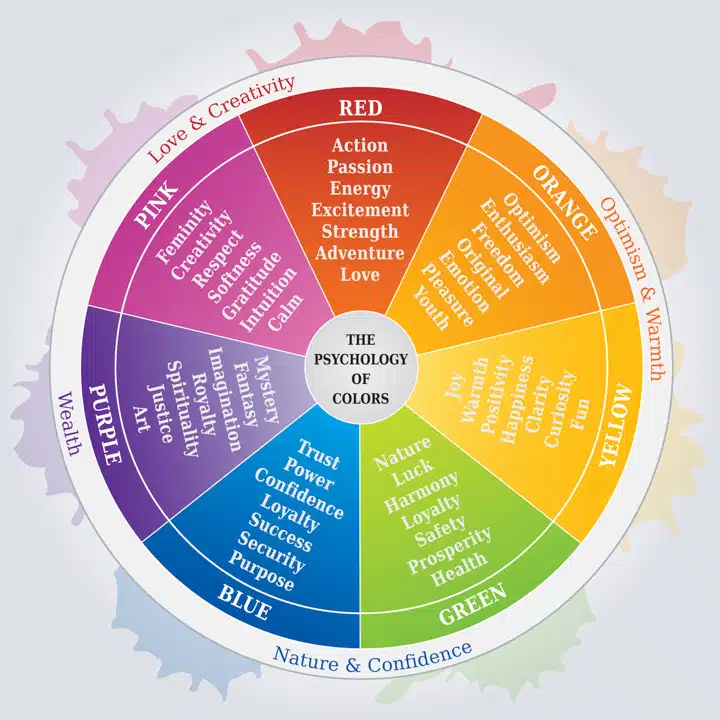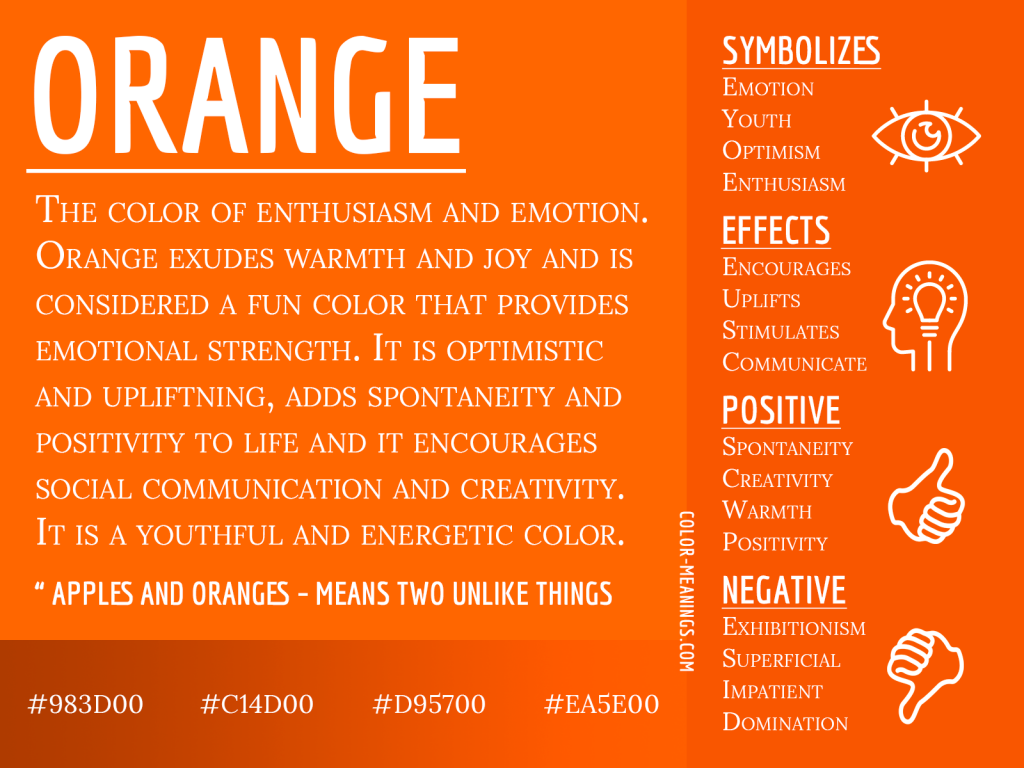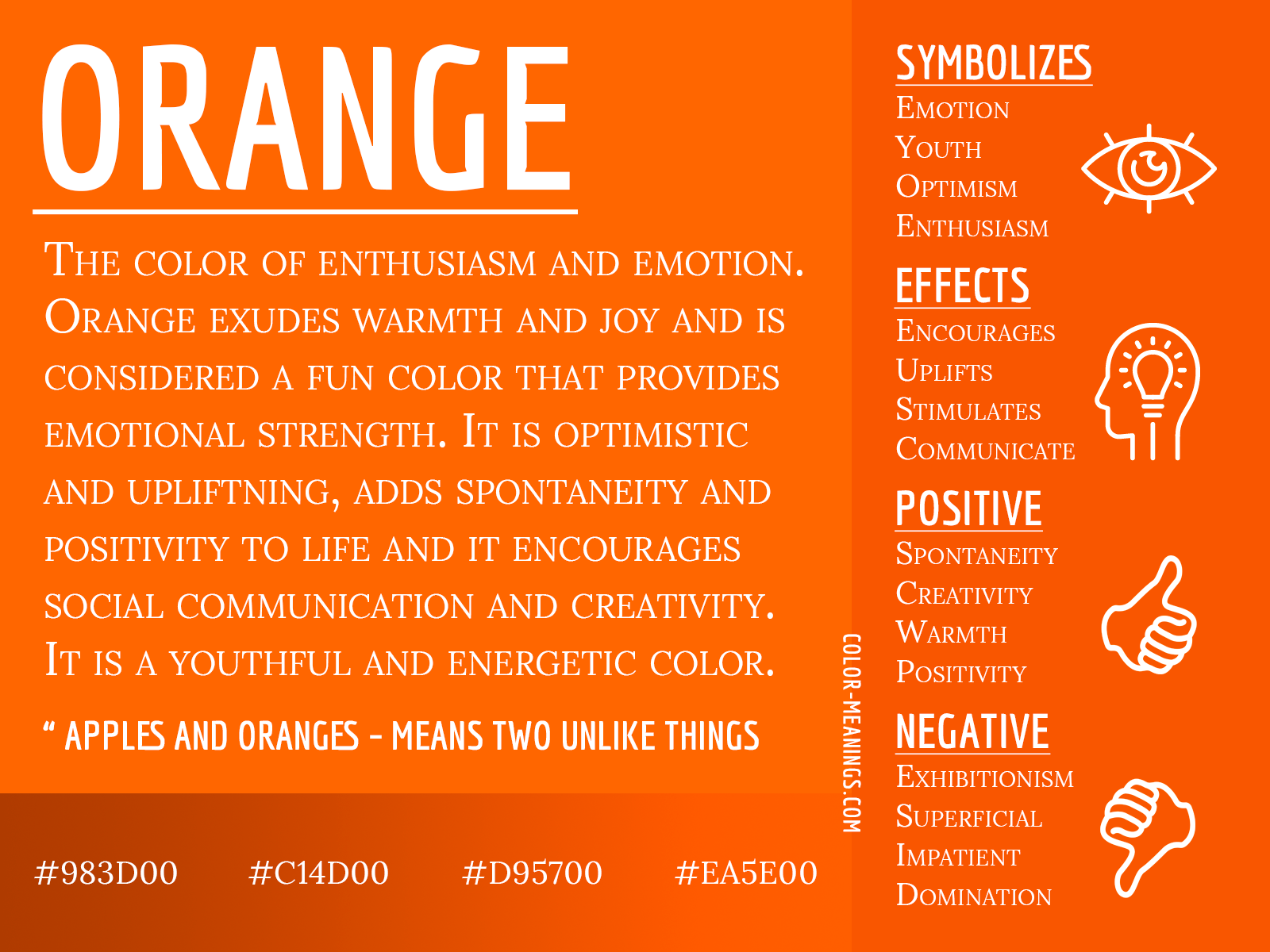The color orange symbolizes freshness, excitement, warmth, and high energy. It is connected to nature and changing seasons and is often associated with creativity and possibility.
In addition, orange is used in sports branding for its competitive energy and is also a warning color for danger and safety equipment. In spiritual practices, orange is linked to meditation, compassion, and the release of materialism, while in Eastern cultures, it represents good fortune and happiness.
Moreover, in love, orange signifies strong attraction, fiery passion, and a deep longing for connection. The psychology of the color orange reveals its association with optimism, happiness, enthusiasm, and youthful connections, as well as its potential to elicit feelings of arrogance, pride, and impatience.
The Vibrancy Of Orange
Orange is a vibrant color that symbolizes freshness, excitement, and warmth. It is connected to nature and changing seasons, and is often used in branding for its high energy and competitiveness. Additionally, orange can represent danger and is commonly seen on safety equipment.
Cultural Significance
In many Eastern cultures, such as China, the color orange holds significant cultural value. It is associated with good fortune, happiness, and prosperity. The vibrant and energetic nature of orange is believed to attract positive energy and bring about success and abundance. Orange is also commonly used in traditional ceremonies and festivals to symbolize joy and celebration.
Emotional Impact
The color orange has a powerful emotional impact on individuals. It is often associated with feelings of warmth, enthusiasm, and excitement. The bright and vibrant nature of orange can uplift mood and create a sense of positivity and optimism. Orange is also known to stimulate creativity and encourage self-expression. It is a color that evokes a sense of adventure and encourages individuals to step out of their comfort zones and embrace new experiences.
When it comes to relationships, orange is associated with the beginnings of a romantic connection. It symbolizes passion, desire, and attraction. The color orange can create a sense of playfulness and openness, making it an ideal choice for creating a lively and stimulating environment.
In addition to its emotional impact, orange also holds spiritual significance. In many spiritual traditions, orange is associated with the sacral chakra, which represents creativity, passion, and emotional expression. It is a color that encourages individuals to embrace their inner desires and tap into their artistic abilities. Orange is often used in meditation practices as it helps to stimulate the mind and promote focus and clarity.
Overall, the vibrant and energetic nature of the color orange makes it a symbol of positivity, creativity, and emotional expression. Whether it is used in cultural celebrations, branding, or personal expression, orange has the power to evoke feelings of joy, excitement, and possibility.

Credit: www.dunnedwards.com
Historical Context Of Orange
Orange is a color that symbolizes freshness, excitement, and warmth. It is often associated with nature, changing seasons, and high energy. Orange is also used as a warning color and is commonly seen on safety equipment. In spiritual practices, orange represents simplicity, letting go of materialism, and is often linked to meditation and compassion.
Additionally, in some cultures, orange is associated with good fortune and happiness.
Ancient Uses
Orange has a rich historical context, with ancient civilizations recognizing its vibrant hue and incorporating it into their cultures. In ancient Egypt, orange was associated with the sun god Ra and was often used in religious ceremonies. The Egyptians also used orange pigments to create colorful artwork and decorate their temples. In ancient China, orange was considered a symbol of good luck and prosperity. It was commonly used in traditional celebrations and festivals to bring joy and happiness to the participants. Orange was also used in ancient Greece and Rome to symbolize vitality and fertility.
Evolution In Symbolism
Throughout history, the symbolism of orange has evolved and expanded. In the Middle Ages, orange became associated with the fruit of the same name, which was considered a luxury item and a symbol of wealth and prestige. The vibrant color of oranges was also associated with creativity and inspiration, leading to its use in artistic endeavors. In more recent times, orange has come to symbolize energy, enthusiasm, and optimism. It is often used to represent youthfulness and playfulness, making it a popular choice in branding and advertising. Orange is also associated with the autumn season, symbolizing the changing colors of leaves and the harvest.
In conclusion, the historical context of orange reveals its significance in ancient civilizations and its evolution in symbolism over time. From its association with the sun god Ra in ancient Egypt to its representation of wealth and creativity in the Middle Ages, orange has played a prominent role in human culture. Today, orange is widely recognized for its energetic and vibrant qualities, symbolizing enthusiasm, optimism, and the changing seasons.
Orange In Nature
Orange in nature symbolizes freshness, excitement, and warmth. It is often connected to the changing seasons and is used to represent danger and safety. In addition, orange is associated with creativity, possibility, and spiritual practices such as meditation and compassion.
Seasonal Associations
Orange is a color that is closely associated with the changing seasons. In the fall, the leaves on trees turn orange, and pumpkin patches are full of bright orange pumpkins. Orange is also associated with Halloween, which is celebrated in many countries around the world. During this holiday, people decorate their homes with orange and black decorations and dress up in costumes.
In the spring, orange is associated with the blooming of flowers and the return of warmer weather. Orange flowers such as marigolds and poppies are often seen in gardens and parks, and the bright orange color of the sun as it sets on the horizon is a sign that summer is on its way.
Natural Warnings
Orange is also a color that is often used as a warning in nature. Many animals, such as poisonous frogs and snakes, have bright orange coloring to warn predators that they are dangerous. This is known as aposematism.
In addition to animals, orange is also used on safety equipment such as traffic cones, life jackets, and hazard signs. This is because orange is a highly visible color that can be easily seen from a distance, making it an effective way to alert people to potential dangers.
Psychological Effects
When it comes to psychological effects, the color orange is known for its stimulating and energizing properties. Let’s delve into the different ways in which this vibrant hue influences our mental and emotional well-being.
Stimulating Creativity
The color orange is often associated with stimulating creativity. Its bold and energetic nature encourages innovative thinking and can spark inspiration in various artistic endeavors. Whether used in art therapy or creative workspaces, orange has the power to ignite imagination and foster originality.
Influence On Mood
Orange exerts a significant influence on mood, thanks to its warm and invigorating essence. It has the ability to evoke feelings of enthusiasm, vitality, and optimism. This uplifting hue can elevate spirits and inject a sense of positivity into the environment, making it a valuable asset in combating feelings of lethargy or despondency.
Spiritual Connotations
The color orange symbolizes creativity, possibility, and emotional expression, making it a powerful and vibrant hue. In spiritual practices, it is associated with meditation and compassion. Additionally, in Eastern cultures, orange represents good fortune and happiness, while in the West, it signifies optimism, enthusiasm, and youthful connections.
Eastern Traditions
In Eastern cultures such as China and Japan, orange is considered a sacred color that represents good luck, happiness, and prosperity. It is also associated with spirituality and is often used in Buddhist and Hindu traditions as a symbol of purity, wisdom, and enlightenment. In Hinduism, orange is associated with the sacral chakra, which is believed to govern creativity, sexuality, and emotional expression. The color is also used in traditional Chinese medicine to treat depression and anxiety.
Chakra And Energy
Orange is associated with the sacral chakra, which is located in the lower abdomen. This chakra is believed to be the center of creativity, passion, and emotional expression. When the sacral chakra is balanced, we feel confident, creative, and connected to our emotions. However, when it is blocked or underactive, we may experience feelings of anxiety, self-doubt, and a lack of creative energy. Wearing orange clothing or incorporating orange into our environment can help to balance the sacral chakra and promote emotional healing.
In conclusion, orange is a color that holds significant spiritual connotations in many cultures and traditions. Whether it is used to represent good luck, enlightenment, or emotional healing, orange has the power to evoke strong emotions and connect us to our inner selves.
:max_bytes(150000):strip_icc()/the-color-psychology-of-orange-2795818-4d1edd20270b48e9afe800d509acbbde.jpg)
Credit: www.verywellmind.com
Orange In Fashion And Design
Orange is a symbol of freshness, excitement, and warmth, often associated with nature and changing seasons. It signifies high energy, competitiveness, and danger, making it a popular choice for sports teams and safety equipment. Additionally, in spiritual practices, orange represents meditation, compassion, and creativity.
Orange in Fashion and Design:
Orange has always been a popular color choice in the fashion and design industry. From bright neon to muted peach, this color has evolved over time. Let’s take a look at the trends over time and the impact of orange on perception.
Trends Over Time:
Orange has been in and out of fashion since the 1960s. The 60s saw the popularity of bright neon orange, while the 70s saw the rise of burnt orange. In the 80s, orange became more muted with pastel shades, and the 90s saw the popularity of peachy orange tones. In recent years, we’ve seen a return of bold, neon shades of orange in fashion and design.
Impact on Perception:
The color orange has a significant impact on our perception. It is associated with happiness, warmth, and creativity. In fashion and design, orange is often used to create a sense of playfulness and energy. It’s commonly used in branding to create a sense of excitement and enthusiasm. However, too much orange can also create a sense of aggression and overstimulation.
In conclusion, orange has always been a popular color choice in fashion and design. Its versatility and impact on perception make it a powerful tool in branding and design. Whether you choose a bold neon shade or a muted peach tone, orange is sure to make a statement.
Symbolism In Art And Literature
The color orange symbolizes feelings of freshness, excitement, and warmth. It is associated with nature, changing seasons, and high energy. Orange also represents creativity, possibility, and the beginnings of a relationship, while in some cultures it signifies good fortune and happiness.
Additionally, it is linked to spiritual practices, such as meditation and compassion.
Symbolism in Art and Literature
The color orange has been used symbolically in both art and literature throughout history. Here are some examples of how the color orange has been used in artistic representations and literary metaphors.
Artistic Representations
In art, orange is often used to represent energy, warmth, and excitement. It can also be used to symbolize the changing seasons, particularly autumn. Some famous paintings that use orange as a prominent color include Vincent van Gogh’s “Starry Night,” Edvard Munch’s “The Scream,” and Claude Monet’s “Impression, Sunrise.”
Literary Metaphors
In literature, the color orange is often used metaphorically to represent energy, warmth, and creativity. For example, in F. Scott Fitzgerald’s “The Great Gatsby,” the character of Daisy is described as having “bright eyes and a bright passionate mouth,” which are both associated with the color orange. In J.D. Salinger’s “The Catcher in the Rye,” the protagonist Holden Caulfield wears an orange hunting hat as a symbol of his individuality and non-conformity.
Overall, the color orange has been used symbolically in both art and literature to represent energy, warmth, creativity, and individuality. Its vibrant and bold nature makes it a powerful tool for artists and writers alike.

Credit: www.color-meanings.com
Functional Uses Of Orange
Orange is not just a visually appealing color, but it also serves various functional purposes. Its vibrant and attention-grabbing nature makes it an excellent choice for several practical applications.
Safety And Visibility
Orange is widely used in safety equipment and clothing due to its high visibility. It is commonly employed in construction sites, roadwork zones, and hunting gear to ensure individuals are easily spotted, enhancing safety in potentially hazardous environments.
Branding And Marketing
Businesses often utilize orange in their branding and marketing strategies to evoke a sense of enthusiasm, energy, and excitement. This dynamic color can create a strong brand identity and attract attention, making it an ideal choice for logos, promotional materials, and product packaging.
Frequently Asked Questions
What Does The Color Orange Signify?
Orange signifies feelings of freshness, excitement, and warmth. It is connected to nature, changing seasons, and represents high energy and competitiveness. Additionally, it symbolizes danger and is used for safety equipment. In spiritual practices, orange represents meditation, compassion, and letting go of materialism.
What Is The Spiritual Meaning Of Orange?
The spiritual meaning of orange is associated with freshness, excitement, and warmth. It is also connected to nature and changing seasons. In spiritual practices, orange symbolizes meditation and compassion. Buddhist monks wear orange robes as a symbol of simplicity and letting go of materialism.
Additionally, orange represents creativity, passion, and emotional expression in many spiritual traditions. It is a color that signifies optimism, happiness, enthusiasm, and youthful connections.
What Is The Message Of The Color Orange?
The color orange signifies freshness, excitement, and warmth. It is associated with nature and changing seasons. Orange is often used in sports branding due to its high energy and competitiveness. It also serves as a warning color for safety equipment.
In spiritual practices, orange symbolizes simplicity and letting go of materialism. It represents creativity, possibility, and the beginnings of a relationship. In some cultures, orange is linked to good fortune and happiness. Overall, orange conveys optimism, enthusiasm, and youthful connections.
What Power Does The Color Orange Represent?
The color orange represents freshness, excitement, and warmth. It is associated with nature, changing seasons, and high energy. Many sports teams use orange for branding due to its competitive feel. Orange also serves as a warning color and is used on safety equipment.
In Eastern cultures, orange is linked to good fortune and happiness. Spiritually, orange symbolizes creativity, passion, and emotional expression.
What Emotions Does The Color Orange Evoke?
Orange evokes feelings of freshness, excitement, and warmth. It is connected to nature and changing seasons. Many sports teams choose orange for their branding because it has high energy and increases competitiveness. Orange is also used on safety equipment to warn of danger.
Conclusion
The color orange symbolizes warmth, excitement, and creativity. It is associated with nature, change, and spiritual practices. Orange also signifies energy and competition, often used by sports teams for branding. Additionally, it can represent danger and is commonly used on safety equipment.
Embracing the vibrant power of orange can bring optimism, happiness, and enthusiasm.

